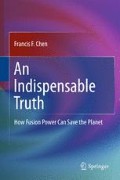Abstract
The energy of the nucleus can be tapped two ways: by splitting large nuclei into smaller ones (fission) or by combining small nuclei into larger ones (fusion). The first yields what we know as atomic or nuclear (fission) energy, together with its dangers and storage problems. The second gives fusion energy, which is basically solar power, since that is the way the sun and stars generate their energies. Fusion is much safer than fission and requires as fuel only a little bit of water (in the form of D2O instead of H2O, as will soon be clear). Fission is a well-developed technology, while fusion is still being perfected as an energy source. The object of this book is to show how far fusion research has gone, how much further there is to go, and what we will gain when we get there.
Numbers in superscripts indicate Notes and square brackets [] indicate References at the end of this chapter.
Access this chapter
Tax calculation will be finalised at checkout
Purchases are for personal use only
Notes
- 1.
Notes
The difference between “weight” and “mass” is purposely ignored at this point.
- 2.
K is the same size as 1°C (also called Celsius) and about twice (actually 9/5) as large as 1°F. The only difference between kelvin and degree centigrade is that kelvin is measured from absolute zero (−273°C), while degree centigrade is measured from the freezing point of water. Fahrenheit is measured from an archaic point such that water freezes at 32°F. At −40°, the temperature is the same in both °C and °F. When we are dealing with millions of degrees, the 273° difference between K and °C is totally insignificant, and even the factor of 2 difference between °K and °F can be ignored unless you are a scientist. The average person couldn’t care less whether the sun is at 1 million degrees or 2 million degrees; it is just hot beyond comprehension.
- 3.
These are the particles of the van Allen belt.
- 4.
“Clerk” is pronounced “Clark.”
- 5.
For those who prefer a formula, the Lorentz force is FL = q (v ¥ Β), where q is the charge and v ¥ Β is the cross-product between the vectors for the particle velocity and magnetic field, respectively.
- 6.
Refrigerator magnets seem to have a force in the direction of the magnetic field coming out of them. The reason permanent magnets do not move sideways like a charged particle is that they are macroscopic objects which feel the sum of the forces on all the individual atoms in them. If we cut the magnet in Fig. 4.8a horizontally, we get two bar magnets which attract each other directly. But permanent magnets are made up of small current loops like the large one in Fig. 4.8b. Suppose we divide that large coil into two coils, one on top of the other, with a gap in between, each coil represents one permanent magnet. Now consider the force between the loops just above or below the gap. The electrons inside the wire carry the current in the circular (azimuthal) direction. The magnetic field of the upper loop flares out so that, at the position of the lower loop, it is partly in the radial direction. The Lorentz force on the electrons in the lower loop is then perpendicular to both the azimuthal and the radial directions, and it is therefore in the vertical direction. The two coils will then attract each other. Thus, the force appears to be in the direction of the field of the entire system.
- 7.
Magnetic mirrors are an exception. They will be described in Chap. 10.
- 8.
Modern stellarators are still a major option being developed. These will be described in Chap. 10 .
- 9.
For those who want to follow this more closely, the direction an ion gyrates in its cyclotron orbit is given by the right-hand rule. If the thumb of the right-hand points along the magnetic field, curled fingers will point in the direction an ion gyrates. Electrons will gyrate in the opposite direction, to the delight of lefties. Similarly, if the thumb points in the direction of a current, the magnetic field it generates will point in the direction of the fingers.
Author information
Authors and Affiliations
Rights and permissions
Copyright information
© 2011 Springer Science+Business Media, LLC
About this chapter
Cite this chapter
Chen, F.F. (2011). Fusion: Energy from Seawater. In: An Indispensable Truth. Springer, New York, NY. https://doi.org/10.1007/978-1-4419-7820-2_4
Download citation
DOI: https://doi.org/10.1007/978-1-4419-7820-2_4
Publisher Name: Springer, New York, NY
Print ISBN: 978-1-4419-7819-6
Online ISBN: 978-1-4419-7820-2
eBook Packages: Physics and AstronomyPhysics and Astronomy (R0)

